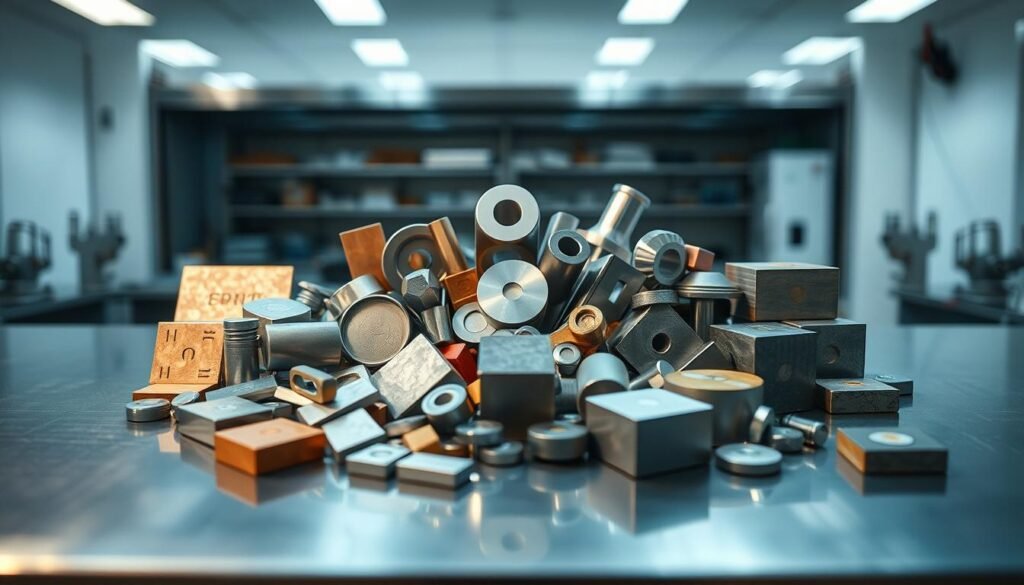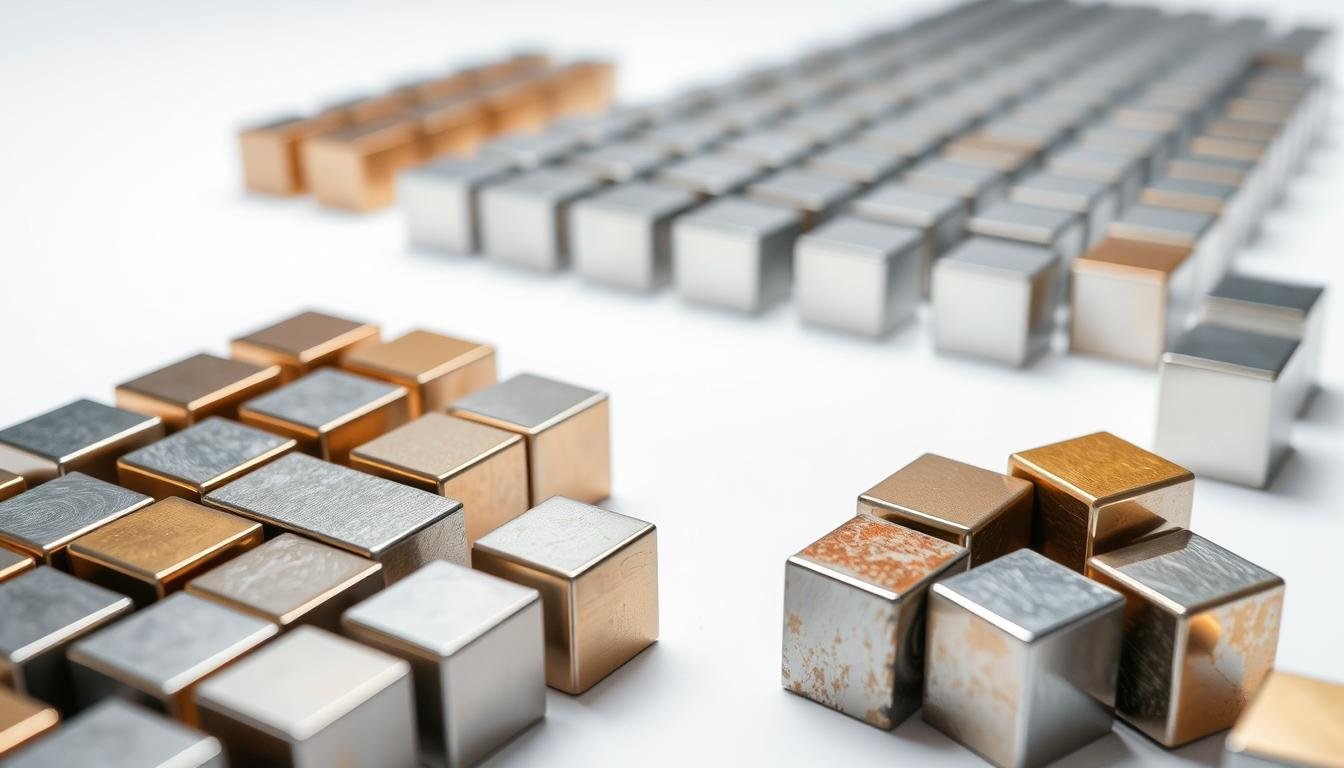The density of metals is key in studying material properties. It’s vital in many industries. Density is a basic trait of materials, helping in metal identification.
It guides engineers and scientists in choosing the right materials. Knowing how density affects metals leads to better designs. This is true in construction, manufacturing, and recycling.
Exploring metal density is very important. It affects both practical uses and scientific research.
Introduction to Density
Density is more than just a term; it’s a key concept in science. It shows how much mass a substance has compared to its volume. This makes density very important for figuring out what materials are and what they can do.
In fields like engineering and environmental studies, density matters a lot. It helps us understand how materials work and behave. This knowledge is essential for making things like cars, planes, and buildings.
Learning about density helps us make better choices when picking materials. It shows us how different materials compare. This is super important in industries that need exact material properties.
As we explore density more, we see how it affects many areas. It shapes how things are designed and how they work. The balance between mass and volume is key to making things better and more sustainable.
What is Density?
Density is key in the physical sciences, giving insights into material properties. It shows why different substances act differently under different conditions. This idea is vital in physics, engineering, and material science.
Definition of Density
Density is the mass of an object divided by its volume. It’s a basic concept in material science, showing how much matter is in a space. Density helps us tell materials apart, which is useful for many uses.
Formula for Calculating Density
The density formula is:
ρ = m/V
In this formula, ρ is density, m is mass, and V is volume. Knowing this formula helps us calculate density accurately for many materials. This is important in engineering and environmental studies.
| Material | Density (g/cm³) |
|---|---|
| Water | 1.00 |
| Aluminum | 2.70 |
| Iron | 7.87 |
| Gold | 19.32 |
| Platinum | 21.45 |
These density values show how different materials vary. This highlights its importance in science and practical uses.
Understanding the Density of Metals
Density is key to understanding metals’ characteristics and uses. Looking at the density of common metals shows big differences. These differences come from their atomic structure and how atoms pack together. This info is vital for many industries, like manufacturing and construction.
To see how metal densities compare, check out this table. It lists the density of several metals we use a lot.
| Metal | Density (kg/m³) |
|---|---|
| Aluminum | 2,705 |
| Brass | 8,587 |
| Gold | 19,320 |
| Iron | 7,870 |
| Copper | 8,960 |
| Titanium | 4,506 |
This comparison shows how different metals have different densities. These differences affect how we use them. Knowing about metal density helps us choose the right materials for different jobs. For more on metal density, check out this informative resource.

The Importance of Density in Material Science
Density is key in material science. It helps choose the right materials for different uses. It affects strength, how well materials conduct heat, and how they resist corrosion.
For instance, denser materials are stronger. They work well in tough environments. This makes them great for many applications.
Density is also important for making and recycling materials. Knowing the density helps make materials better and more efficient. It also helps in recycling, making industries more sustainable.
There are different ways to measure density, and each can give different results. This makes knowing density very important. To learn more, check out this detailed resource. Understanding density leads to better use of materials, driving innovation in engineering and design.
| Material | Density (g/cm³) | Strength (MPa) | Corrosion Resistance |
|---|---|---|---|
| Steel | 7.85 | 250-500 | Moderate |
| Aluminum | 2.70 | 70-700 | High |
| Copper | 8.96 | 210-300 | Moderate |
| Titanium | 4.51 | 300-900 | Excellent |
In summary, density is very important in material science. It affects how materials are chosen, perform, and are recycled. Understanding density is essential for improving technology and practices in many industries.
Factors Influencing Metal Density
Density in metals is not just a fixed number. It changes based on several factors. These include the atomic structure and how atoms are arranged. Knowing these helps us understand why some metals are denser than others.
Atomic Structure
The size and mass of a metal’s atoms affect its density. For instance, lead is denser than aluminum because its atoms are heavier. This shows how important atomic structure is in determining density.
Arrangement of Atoms
The way atoms are arranged also impacts density. Metals with atoms packed tightly are denser. Crystalline structures, with atoms in regular patterns, contribute to higher density. On the other hand, less organized structures lead to lighter metals.
| Metal | Atomic Mass (g/mol) | Density (g/cm³) | Atomic Arrangement |
|---|---|---|---|
| Lead | 207.2 | 11.34 | Cubic |
| Aluminum | 26.98 | 2.70 | Face-Centered Cubic |
| Copper | 63.55 | 8.96 | Face-Centered Cubic |
| Iron | 55.85 | 7.87 | Body-Centered Cubic |
Measuring the Density of Metals
Getting the right density of metals is key for checking material quality. There are many ways to measure density. Using different methods helps get more accurate results, which is important for different metals.
Techniques for Density Measurement
There are many ways to measure density, but the most common are weighing and finding the volume. A precise method is to weigh the metal in air and then measure its volume by how much water it displaces. This method is simple and widely used in fields like metallurgy and manufacturing.
Using Water for Density Calculations
Water is great for density calculations because its density is about 1 g/cm3 at room temperature. Here’s how to do it:
- Weigh the metal sample in air.
- Submerge the sample in water and measure the displaced volume.
- Calculate density using the formula: Density = Mass/Volume.
This method is reliable and accurate. It’s shown in studies on metal densities, like those from the Canadian Conservation Institute.
Applications of Metal Density
Metal density is more than just a theory. It’s used in many industries. Knowing the density of metals helps engineers and designers make important choices. This knowledge is key in fields like aerospace, automotive, construction, and recycling.
Industry Relevance
In aerospace, the right metal density is vital for safety and performance. For example, aluminum and titanium alloys make planes lighter and more fuel-efficient. In the automotive world, engineers use metal density to improve car safety and fuel use by choosing the right materials.
Implications for Engineering and Design
Metal density affects engineering and design in big ways. The right density helps meet strength needs for different uses. Architects and builders use this knowledge to make sure big structures are stable.
Here’s a table showing some metals, their densities, and where they’re used:
| Metal | Density (g/cm³) | Typical Applications |
|---|---|---|
| Aluminum | 2.7 | Aerospace structures, automotive components |
| Steel | 7.85 | Construction, machinery, tools |
| Titanium | 4.51 | Aerospace, medical implants |
| Copper | 8.96 | Electrical wiring, plumbing |
Comparative Analysis of Metal Densities
Looking at the density of metals shows us how they are used in different fields. Dense metals like Gold and Platinum have special qualities. On the other hand, Aluminum and Titanium are lighter and more flexible.
Examples of Dense Metals
Dense metals are key in certain areas because of their high atomic weights. Gold and Platinum are great for electronics and jewelry because they don’t rust and conduct well. They are vital for top-notch electronics and fancy items.
Lead, though heavy, is mainly used for blocking radiation. Its density and mass make it perfect for this job.
Light Metals and Their Uses
Light metals are also very important, mainly for saving energy and improving performance. Aluminum and Titanium are great examples. They are light but strong.
Aluminum is perfect for planes and cars because it’s light. This helps save fuel and boost performance. Titanium is used in space and medicine because it’s strong but light.
| Metal | Density (g/cm3) | Main Applications |
|---|---|---|
| Gold | 19.32 | Electronics, Jewelry |
| Platinum | 21.45 | Catalytic Converters, Jewelry |
| Lead | 11.34 | Radiation Shielding |
| Aluminum | 2.70 | Aerospace, Automotive |
| Titanium | 4.51 | Aerospace, Medical Devices |
The Role of Density in Recycling Metals
Knowing the recycling metal density is key to good metal recycling processes. Metals with high density need special methods for separation. This makes recycling more efficient and helps the environment.
Different metal densities help recyclers sort metals from mixed materials. They use methods like flotation and gravity separation. This way, metals like aluminum and copper are processed correctly. It makes recycling more efficient and supports sustainability.
Using metal density knowledge in recycling helps the environment. It’s important for businesses to reduce their carbon footprint. Recycling metal density is a big part of this, helping create a circular economy.
| Metal Type | Density (g/cm³) | Recycling Process |
|---|---|---|
| Aluminum | 2.70 | Shredding, melting |
| Copper | 8.96 | Separation, electrolysis |
| Steel | 7.85 | Magnetic separation, remelting |
| Lead | 11.34 | Smelting, casting |

How Density Affects Conductivity and Strength
Material science shows us how density impacts electrical conductivity and mechanical strength. Denser metals often have better electrical conduction and strength. This is because their atoms are packed tightly.
Electrical Conductivity
Denser metals like copper and silver conduct electricity better. Their atomic structure allows electrons to move freely. This makes electrical flow efficient. Lighter metals, like aluminum, conduct electricity but not as well.
Mechanical Strength
Denser metals are also stronger mechanically. They can handle more stress without breaking. For example, titanium is strong and light, making it great for aerospace.
On the other hand, lighter metals are better for saving weight. This is why they’re used in cars.
| Metal Type | Density (g/cm³) | Electrical Conductivity (MS/m) | Yield Strength (MPa) |
|---|---|---|---|
| Copper | 8.96 | 58.0 | 210 |
| Aluminum | 2.70 | 37.7 | 70 |
| Silver | 10.49 | 63.0 | 70 |
| Titanium | 4.51 | 16.0 | 830 |
Common Misconceptions About Metal Density
Many people think all metals are heavy, but this isn’t true. Metals like lithium and aluminum are actually lighter than metals like lead and tungsten. Knowing this is key for engineering and design.
Some think density alone shows a metal’s strength. But, *density is just part of the story*. The way atoms are arranged in a metal also matters a lot. Choosing the right metal for a job requires understanding this.
When recycling, knowing about metal density is important. Misunderstandings can lead to wrong sorting. Learning about metal density helps us recycle better and understand materials better too.
Future Trends in Metals and Density Research
The study of metal density is getting more exciting, thanks to new discoveries. Nanotechnology is leading the way. It makes metals stronger and lighter by changing them at a tiny scale.
This breakthrough could change many industries. It helps make things more efficient and eco-friendly. It’s a big step forward.
New alloys are also being developed. They can handle very high temperatures and pressures. This is great news for the aerospace and car industries.
These alloys are lighter but just as strong. This means cars and planes can go faster and use less fuel. It’s a win-win for everyone.
Researchers are getting better at making and testing metals. New methods like additive manufacturing are on the horizon. They promise to create metals with specific properties.
This could lead to materials that are perfect for certain jobs. It’s a big leap for material science. It will change how we make things and design products.

Conclusion
Exploring metal density gives us key insights into materials’ properties. It’s vital for many industries. Knowing about metal density helps choose the right materials for projects.
This knowledge is not just for learning. It affects how well things work in fields like aerospace and construction. It’s about making things better and more efficient.
Understanding density also helps make designs better and more sustainable. It guides us in recycling materials wisely. As technology grows, so does our ability to use metals in new ways.
For those in material science and engineering, knowing about metal density is essential. It helps us use materials more wisely. This way, we can create solutions that meet and exceed today’s needs.
